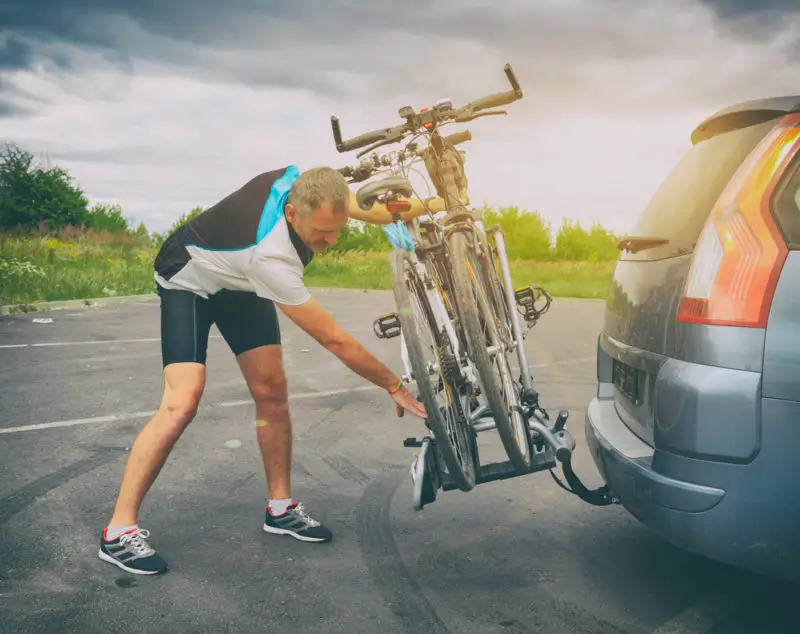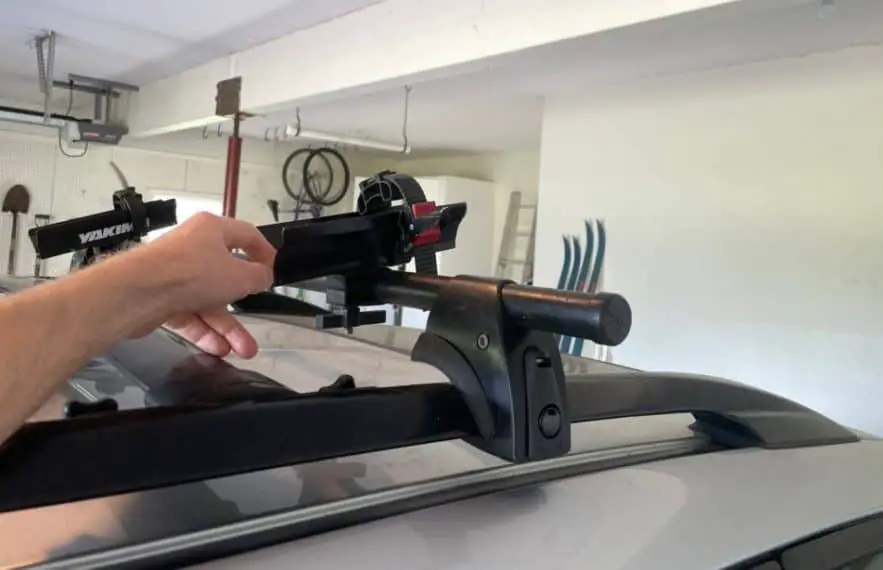As I was looking into purchasing a bike rack, I realized there’s one aspect of using a rack that people don’t always think about. We consider whether a bike rack is compatible with your car or bike, how secure it is, and how easy it is to install, but we don’t think to ask the question:
Once installed, are bike racks removable? Is removal a pain?
Bike racks are removable; they are not a permanent installation. However, some racks are much easier to remove than others. Trunk racks are probably the easiest to remove, while roof racks are probably the most difficult. Hitch racks and truck bed racks aren’t necessarily challenging to remove, but they’re heavy.
In this article, we’ll take a look at how easy it is to remove each type of bike rack from your car, as well as whether or not you should leave your rack on your car when you’re not using it.
Let’s get started!
Bike Racks Are Removable (Not Permanent)

Bike racks are not permanently installed on your vehicle. Instead, they are designed to be removed when you aren’t using them. There are several reasons you don’t want your bike rack to be permanently installed on your vehicle.
If bike racks were designed to be permanent, this alteration to your vehicle could damage or reduce the value of it. In addition, you would probably need to have them professionally installed, increasing the cost associated with the rack.
Drawbacks to Driving with Bike Racks installed
There are some drawbacks to driving with bike racks installed when you aren’t using them, which is a good reason they are not permanent.
Bike racks stick out and alter your vehicle’s profile as well as obstruct your view out the rear window (some can even block the backup camera) which can make accidents more likely. Think of all the people who have driven into a garage with a roof rack or backed into another car because they forgot about their hitch rack!
Leaving a bike rack on your car could also make you a target for theft. So it only makes sense that bike racks would be removable so you can store them safely away when you don’t need them.
Many bike racks limit or completely block access to the trunk, so permanently installing them would mean you can’t access the cargo area of your vehicle.
Are Bike Racks Easy or Hard to Remove?

Bike racks can be somewhat cumbersome to remove and install. However, this is a necessary part of using a rack. Some racks are harder to remove than others; it just depends on the type of rack you have installed on your car.
Removal Difficulty for Each Type of Bike Rack
Trunk Rack
Trunk racks are installed on the trunk or hatch of your vehicle using a system of straps and hooks. Trunk racks are designed to hold a single bike or several bikes. They’re light, making them one of the easiest types of rack to be installed and removed. It’s a matter of loosening the straps and undoing the clips that hold the rack to the car’s trunk lid.
Once removed, you can fold the rack for easy storage.
Spare Tire Rack
Spare tire racks are racks that attach to the spare tire mount on the back of an SUV. These racks are also light, easy to install, remove, and fold up for storage. Spare tire racks will usually only carry two bikes but will allow you to have access to the trunk area while the rack is installed.
Hitch Rack
In theory, installing and removing a hitch rack is simple, but they are quite heavy and hard to manage.
Pull the pin that holds it to the hitch, then slide the rack out of your vehicle’s hitch, and you’re all done. The process is quite simple and easy to accomplish.
However, it can be very difficult to handle a heavy, bulky hitch rack by yourself, especially one designed to carry multiple heavier bikes like mountain bikes and e-bikes.
Though they are one of the best racks for transporting multiple heavier bikes, hitch racks take up a lot of room when being stored. They typically don’t fold up as compactly as trunk racks.
Roof Rack
Roof racks are the type of racks that get left on vehicles the most. Roof racks are probably the hardest to uninstall, not because of the process but because of their location on the vehicle.
It isn’t easy to lift and remove the heavy rack from on top of your car. And if your vehicle is tall, that makes it even more difficult.
On the one hand, if you are someone who will be leaving the rack on your vehicle for extended periods of time, this might be the best rack for you. But on the other hand, you have to be extremely cautious with roof racks so you don’t hit the rack or your bike when driving under bridges, drive-thrus, or even your garage. Since you can’t see a roof rack as easily, you may forget it’s there until it’s too late!
Truck Rack
There are two common types of truck racks. One is a bed rack, and the other is a tailgate rack. The truck bed rack uses a tension-mounted bar to attach to your truck bed. The tension bar keeps your rack – and your bikes- securely in place, fully contained within the bed of your truck. These racks are simple to install, but they might feel a bit cumbersome because they are designed to hold several bikes.
A tailgate rack is a vinyl pad that fits over the back of your tailgate and is secured with a system of straps. A bike’s front wheel and fork are draped over the tailgate and strapped into the pad, with the rest of the bike secured within the bed. The pads are heavy, but the straps are no more complicated to install and remove than the straps of a trunk rack.
You may have difficulty lifting either rack in and out of the truck bed due to their size and weight., so it’s advisable to recruit a friend to help.
Should You Leave a Bike Rack on Your Car
Technically, you can leave your bike rack on your car at all times. It is designed to be attached safely to your car. But that doesn’t mean it’s a good idea. First, as mentioned earlier, leaving a bike rack on your car can be a safety hazard. It can change the way your car handles and may even cause an accident if you forget the rack is there.
Second, bike racks will deteriorate faster if left out in the elements. Leaving your rack attached and exposed to rain, snow, road salt, dirt or chemicals can cause wear and tear that may affect your rack’s ability to safely hold your bikes.
Third, a rack that blocks your license plate may result in a ticket (not all places have exemptions for bike racks).
And lastly, leaving your bike rack on at all times could make you a victim of theft.
So when you aren’t using your bike rack, it’s best just to take it off and store it in a safe place.
